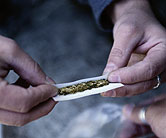
WEDNESDAY, Dec. 19 (HealthDay News) — Current — and in some cases, rising — levels of marijuana use by 8th, 10th and 12th graders are cause for concern, U.S. health officials said Wednesday.
Moreover, the misperception that marijuana is harmless continues to grow among teens, according to a report released by the White House Office of National Drug Control Policy.
However, the report included some positive news, too.
“There are significant reductions in use for many drugs including illegal ones,” said Dr. Nora Volkow, director of the U.S. National Institute on Drug Abuse, which funded the survey. “Unfortunately, on the bad side, we are sustaining very high levels of marijuana use. At the same time the perception of the harm of marijuana use is at the lowest it’s ever been — this is concerning.”
It is this perception that is driving the increasing use of marijuana, Volkow said. “This is despite the fact that using marijuana during adolescence is harmful to the human brain,” she said.
In 2012, 6.5 percent of high school seniors said they smoked marijuana every day — that’s up from 5.1 percent in 2007, according to the report.
And almost 23 percent of these students said they had smoked marijuana in the month before the survey was done, and 36 percent admitted to smoking marijuana in the past year.
Among 10th graders, 3.5 percent said they smoked marijuana daily and 17 percent said they used the drug in the past month, while 28 percent used it in the past year, according to the survey.
Marijuana use goes up after 8th grade, the researchers found. Only 1.1 percent of 8th graders said they used it daily; 6.5 percent used it the past month and more than 11 percent used the drug in the past year, the investigators reported.
In addition, only about 42 percent of 8th graders said occasional marijuana use was harmful, while nearly 67 percent said regular use was harmful. These are the lowest rates since the survey began tracking this perception in 1991.
Moreover, as teens get older and marijuana use increases, the perception of the drug’s harmfulness declines. Among 12th graders, only about 21 percent think occasional use is harmful and only 44 percent think regular use is harmful, the report states.
Volkow blamed the perception of marijuana as harmless on media attention to the drug and to its legalization in several states. Removing the legal barrier means people who would not have used the drug because it was against the law now will, she pointed out.
The survey was conducted by researchers at the University of Michigan. In all, more than 45,000 students from almost 400 public and private schools participated in this year’s survey.
A more encouraging finding was that use of other drugs among teens had a steady modest decline. For example, in the past year, except for marijuana, drug use among teens was the lowest for all grades. For 8th graders it was 5.5 percent, while it was 10.8 percent for 10th graders and 17 percent for 12th graders.
In the past year, use of Ecstasy among 12th graders dropped to 3.8 percent, down from 5.3 percent a year ago, the researchers noted.
For the first year, the survey included the use of drugs known as “bath salts.” These drugs contain an amphetamine-like stimulant and are often sold in drug paraphernalia stores.
The use of these drugs was relatively low, the report noted. Among 12th graders, for example, only 1.3 percent said they used them in the past month.
As for the use of the hallucinogenic herb Salvia, its use dropped among 10th and 12th graders. Last year 5.9 percent of 12th graders said they used this drug. This year that decreased to 4.4 percent.
Other highlights of the report include:
- Use of synthetic marijuana, known as K2 or Spice, was stable in 2012 at just over 11 percent of 12th graders.
- Use of inhalants continued a downward trend dropping to 6.2 percent for 8th graders from 8.3 percent in 2007.
- Use of prescription narcotic painkillers like Vicodin declined.
- Use of the stimulant Adderall (used to treat attention-deficit/hyperactivity disorder) increased among high school seniors as the perception of its harm decreased.
- Use of cold medicines containing dextromethorphan remains steady at about 5.6 percent among high school seniors.
- Alcohol use also declined to 29 percent of 8th graders from 33 percent a year ago; among 10th graders its use declined from 72 percent in 1997 to 54 percent.
- Binge drinking rates declined to 5.1 percent from 6.4 percent last year among 8th graders.
- Cigarette smoking reached its lowest level among all teens.
- Use of small cigars and hookah water pipes rose to nearly 20 percent of high school seniors.
More information
For more facts on teen drug abuse, visit the Nemours Foundation.

